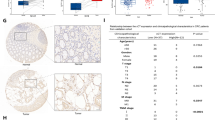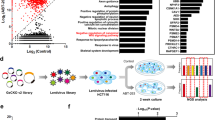Abstract
EGR4 (Early Growth Response 4) is a member of the EGR family, involving in tumorigenesis. However, the function and action mechanism of EGR4 in the pathogenesis of colorectal cancer (CRC) remain unclear. To address this, we assessed the prognosis of CRC based on EGR4 using the Kaplan-Meier plotter tool and tissue microarray. The abundance of immunoinfiltration was evaluated through ssGSEA, TISIDB, and TIMER. In vitro experiments involving knockdown or overexpression of EGR4 were performed, and RNA-sequencing was conducted to explore potential mechanisms. Furthermore, we used oxaliplatin and 5-fluorouracil to validate the impact of EGR4 on chemo-resistance. Pan-cancer analysis and tissue microarray showed that EGR4 was highly expressed in CRC and significantly correlated with an unfavorable prognosis. Moreover, EGR4 expression was associated with immunoinfiltration and cancer-associated fibroblasts in the CRC microenvironment. Functional enrichment demonstrated that high-expressional EGR4 were involved in chromatin and nucleosome assembly. Additionally, EGR4 promoted the proliferation of CRC cells. Mechanistically, EGR4 upregulated TNFα to activate the NF-κB signaling pathway, and its knockdown reduced p65 nuclear translocation. Importantly, combining shEGR4 with oxaliplatin and 5-fluorouracil significantly inhibited CRC proliferation. Taken together, these findings provide new insights into the potential prognosis and therapeutic targets of EGR4 in CRC.
This is a preview of subscription content, access via your institution
Access options
Subscribe to this journal
Receive 12 print issues and online access
$259.00 per year
only $21.58 per issue
Buy this article
- Purchase on Springer Link
- Instant access to full article PDF
Prices may be subject to local taxes which are calculated during checkout







Similar content being viewed by others
Data availability
The datasets generated and analyzed during this study are available in the public database TCGA.
References
Sung H, Ferlay J, Siegel RL, Laversanne M, Soerjomataram I, Jemal A, et al. Global Cancer Statistics 2020: GLOBOCAN Estimates of Incidence and Mortality Worldwide for 36 Cancers in 185 Countries. CA Cancer J Clin. 2021;71:209–49.
Lynch HT, de la Chapelle A. Hereditary colorectal cancer. N Engl J Med. 2003;348:919–32.
Kordahi MC, Stanaway IB, Avril M, Chac D, Blanc MP, Ross B, et al. Genomic and functional characterization of a mucosal symbiont involved in early-stage colorectal cancer. Cell Host Microbe. 2021;29:1589–98.
Coker OO, Nakatsu G, Dai RZ, Wu WKK, Wong SH, Ng SC, et al. Enteric fungal microbiota dysbiosis and ecological alterations in colorectal cancer. Gut. 2019;68:654–62.
Zhao S, Mi Y, Zheng B, Wei P, Gu Y, Zhang Z, et al. Highly-metastatic colorectal cancer cell released miR-181a-5p-rich extracellular vesicles promote liver metastasis by activating hepatic stellate cells and remodelling the tumour microenvironment. J Extracell Vesicles. 2022;11:e12186.
Brenner H, Chen C. The colorectal cancer epidemic: challenges and opportunities for primary, secondary and tertiary prevention. Br J Cancer. 2018;119:785–92.
van Rooijen KL, Shi Q, Goey KKH, Meyers J, Heinemann V, Diaz-Rubio E, et al. Prognostic value of primary tumour resection in synchronous metastatic colorectal cancer: Individual patient data analysis of first-line randomised trials from the ARCAD database. Eur J Cancer. 2018;91:99–106.
Fan A, Wang B, Wang X, Nie Y, Fan D, Zhao X, et al. Immunotherapy in colorectal cancer: current achievements and future perspective. Int J Biol Sci. 2021;17:3837–49.
Sargent D, Sobrero A, Grothey A, O’Connell MJ, Buyse M, Andre T, et al. Evidence for cure by adjuvant therapy in colon cancer: observations based on individual patient data from 20,898 patients on 18 randomized trials. J Clin Oncol. 2009;27:872–7.
Biller LH, Schrag D. Diagnosis and treatment of metastatic colorectal cancer: a review. JAMA. 2021;325:669–85.
Zhong L, Li Y, Xiong L, Wang W, Wu M, Yuan T, et al. Small molecules in targeted cancer therapy: advances, challenges, and future perspectives. Signal Transduct Target Ther. 2021;6:201.
Lin Y, Bai L, Chen W, Xu S. The NF-kappaB activation pathways, emerging molecular targets for cancer prevention and therapy. Expert Opin Ther Targets. 2010;14:45–55.
Wu Y, Zhou BP. TNF-alpha/NF-kappaB/Snail pathway in cancer cell migration and invasion. Br J Cancer. 2010;102:639–44.
Karin M, Greten FR. NF-kappaB: linking inflammation and immunity to cancer development and progression. Nat Rev Immunol. 2005;5:749–59.
Hogarth CA, Mitchell D, Small C, Griswold M. EGR4 displays both a cell- and intracellular-specific localization pattern in the developing murine testis. Dev Dyn. 2010;239:3106–14.
Di Persio S, Tekath T, Siebert-Kuss LM, Cremers JF, Wistuba J, Li X, et al. Single-cell RNA-seq unravels alterations of the human spermatogonial stem cell compartment in patients with impaired spermatogenesis. Cell Rep Med. 2021;2:100395.
O’Donovan KJ, Tourtellotte WG, Millbrandt J, Baraban JM. The EGR family of transcription-regulatory factors: progress at the interface of molecular and systems neuroscience. Trends Neurosci. 1999;22:167–73.
Poirier R, Cheval H, Mailhes C, Garel S, Charnay P, et al. Distinct functions of egr gene family members in cognitive processes. Front Neurosci. 2008;2:47–55.
Matsuo T, Dat le T, Komatsu M, Yoshimaru T, Daizumoto K, Sone S, et al. Early growth response 4 is involved in cell proliferation of small cell lung cancer through transcriptional activation of its downstream genes. PLoS One. 2014;9:e113606.
He S, Lin J, Xu Y, Lin L, Feng J. A positive feedback loop between ZNF205-AS1 and EGR4 promotes non-small cell lung cancer growth. J Cell Mol Med. 2019;23:1495–508.
Gong X, Zou L, Wang M, Zhang Y, Peng S, Zhong M, et al. Gramicidin inhibits cholangiocarcinoma cell growth by suppressing EGR4. Artif Cells Nanomed Biotechnol. 2020;48:53–59.
Baghban R, Roshangar L, Jahanban-Esfahlan R, Seidi K, Ebrahimi-Kalan A, Jaymand M, et al. Tumor microenvironment complexity and therapeutic implications at a glance. Cell Commun Signal. 2020;18:59.
Taube JM, Galon J, Sholl LM, Rodig SJ, Cottrell TR, Giraldo NA, et al. Implications of the tumor immune microenvironment for staging and therapeutics. Mod Pathol. 2018;31:214–34.
Kumar P, Bhattacharya P, Prabhakar BS. A comprehensive review on the role of co-signaling receptors and Treg homeostasis in autoimmunity and tumor immunity. J Autoimmun. 2018;95:77–99.
Kennedy PT, Saulters EL, Duckworth AD, Lim YJ, Woolley JF, Slupsky JR, et al. Soluble CTLA-4 attenuates T cell activation and modulates anti-tumor immunity. Mol Ther. 2023. https://doi.org/10.1016/j.ymthe.2023.11.028.
Lab S, Mallett G, Amarnath S. The depths of PD-1 function within the tumor microenvironment beyond CD8+ T cells. Semin Cancer Biol. 2022;86:1045–55.
Ruffo E, Wu RC, Bruno TC, Workman CJ, Vignali DAA. Lymphocyte-activation gene 3 (LAG3): the next immune checkpoint receptor. Semin Immunol. 2019;42:101305.
Yu X, Harden K, Gonzalez LC, Francesco M, Chiang E, Irving B, et al. The surface protein TIGIT suppresses T cell activation by promoting the generation of mature immunoregulatory dendritic cells. Nat Immunol. 2009;10:48–57.
Kalluri R. The biology and function of fibroblasts in cancer. Nat Rev Cancer. 2016;16:582–98.
Lin Y, Cai Q, Chen Y, Shi T, Liu W, Mao L, et al. CAFs shape myeloid-derived suppressor cells to promote stemness of intrahepatic cholangiocarcinoma through 5-lipoxygenase. Hepatology. 2022;75:28–42.
Sahai E, Astsaturov I, Cukierman E, DeNardo DG, Egeblad M, Evans RM, et al. A framework for advancing our understanding of cancer-associated fibroblasts. Nat Rev Cancer. 2020;20:174–86.
Balkwill F. Tumour necrosis factor and cancer. Nat Rev Cancer. 2009;9:361–71.
Xia L, Mo P, Huang W, Zhang L, Wang Y, Zhu H, et al. The TNF-α/ROS/HIF-1-induced upregulation of FoxMI expression promotes HCC proliferation and resistance to apoptosis. Carcinogenesis. 2012;33:2250–9.
Van Quickelberghe E, De Sutter D, van Loo G, Eyckerman S, Gevaert K. A protein-protein interaction map of the TNF-induced NF-κB signal transduction pathway. Sci Data. 2018;5:180289.
Bakshi HA, Quinn GA, Nasef MM, Mishra V, Aljabali AAA, El-Tanani M, et al. Crocin inhibits angiogenesis and metastasis in colon cancer via TNF-α/NF-kB/VEGF pathways. Cells. 2022;11:1502.
Acknowledgements
Thanks GEO and TEGA for sufficient RNA-sequencing data and clinical information.
Funding
This research was supported by grants from The National Natural Science Foundation of China (82202828, 82000621). Ili Kazakh Autonomous Clinical Research Institute (yl2020ms10). Key Project of GuSu College, Nanjing Medical University (GSKY20220109).
Author information
Authors and Affiliations
Contributions
Bangting Wang, Yan Wang and Li Liu designed the experiments; Bangting Wang, Shijie Zhang and Jiankun Wang performed the experiments; Bangting Wang and Shijie Zhang prepared all figures; Bangting Wang, Shijie Zhang and Haiyang Wang analyzed the data; Zhining Fan and Li Liu supervised the work; Bangting Wang, Jiangkun Wang, Yuwen Tao and Shijie Zhang wrote the manuscript.
Corresponding authors
Ethics declarations
Ethics statement and consent to participate
Data from the TCGA and GTEx databases were used in our study. Our research involves human tissues derived from tumor and adjacent normal tissues of CRC patients. All patients signed an informed consent form. Ethical approval for this study was obtained from the Ethical Committee of Medical Research, Jiangsu Province Hospital of Nanjing Medical University (2018-SR-258). There are no clinical trials or animal experiments in our research.
Competing interests
The authors declare no competing interests.
Consent for publication
All authors agree to publish this paper.
Additional information
Publisher’s note Springer Nature remains neutral with regard to jurisdictional claims in published maps and institutional affiliations.
Supplementary information
Rights and permissions
Springer Nature or its licensor (e.g. a society or other partner) holds exclusive rights to this article under a publishing agreement with the author(s) or other rightsholder(s); author self-archiving of the accepted manuscript version of this article is solely governed by the terms of such publishing agreement and applicable law.
About this article
Cite this article
Wang, B., Zhang, S., Wang, H. et al. Identification of EGR4 as a prospective target for inhibiting tumor cell proliferation and a novel biomarker in colorectal cancer. Cancer Gene Ther (2024). https://doi.org/10.1038/s41417-024-00743-1
Received:
Revised:
Accepted:
Published:
DOI: https://doi.org/10.1038/s41417-024-00743-1



